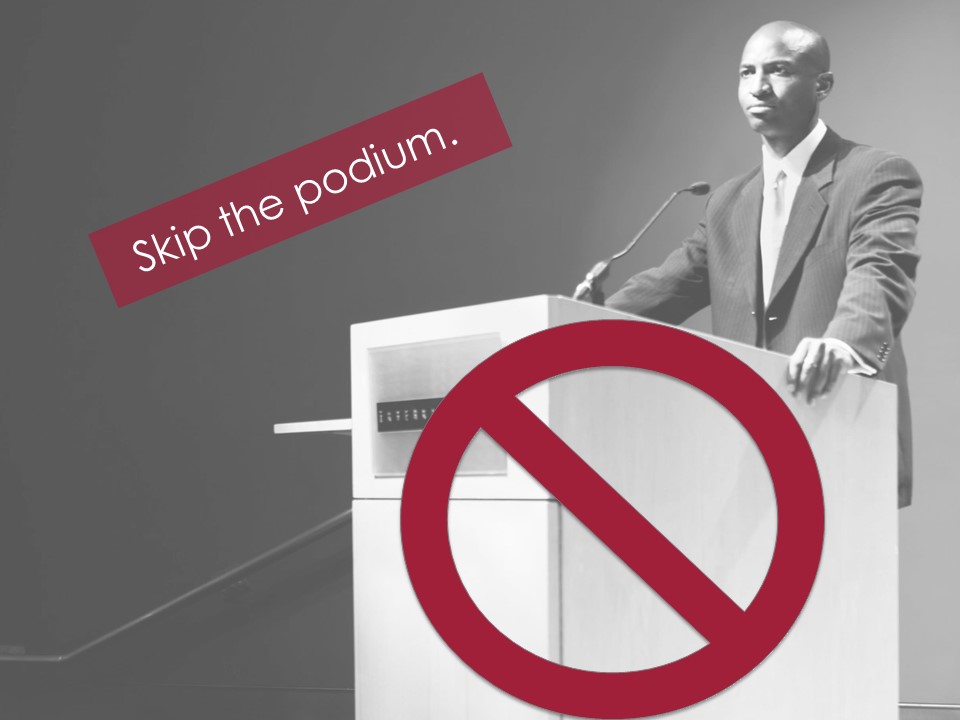-
6 TED Talk rules you could use
So what’s the difference between a TED talk and a corporate presentation? What lessons can corporate speakers borrow from TED to update their corporate events? Here are 6 TED rules that you could use to modernize your next event:
(1) Start early, really early.
TED dictates a schedule so speakers start working on their presentation early. TED presenters must prepare drafts, attend reviews and dress rehearsals. Some TED speakers start 6, or even 12 months in advance. Even last minute presenters work on their speech for at least a couple of months before the big day. And what do they do with all this time? They seek training, think thoroughly about their idea and structure, prepare their slides, and practice their delivery.
On the other hand, many corporate presenters tell me they often create their slides on the plane ride to the meeting venue, and rarely practice. But this isn’t always the case. Leaders of large companies know the importance of communications. They often rely on teams of people to help them, like public relations specialists, speech writers, presentation coaches, and graphic artists. Steve Jobs was well-known for working on his presentation for months in advance, and rehearsing for 3-4 weeks, considering every word, move, and moment in his presentation (Gallo, 2016). If you want to train like TED (or Steve Jobs), start working on your presentation early. While they may look like born presenters, the best presenters are simply well-trained and properly prepared. Just image what you could do, if you start early!
(2) Skip the podium.

If you want to minimize the connection between the speaker and the audience, add a podium. Podiums block body language and provide a big disadvantage for short speakers. Get rid of them. TED typically replaces the podium with a red rug. Whenever I’m directed to speak behind a podium, I feel that someone has just asked me to speak from the jail house. So, my first task is to determine how to unhook the microphone. Podiums create barriers, restrict movement, and block the speakers connection to the audience. For those organizing events, I beg you to let the speakers out of the jail house.
I should note that some people like podiums (anxious presenters and university professors often fall in this category). For insistent speakers, TED has made exceptions. But for nervous speakers, this isn’t the answer. There are several tools that we use to help reduce your anxiety, and none of these tools involve hiding behind a podium.
(3) Create an idea worth spreading.
I often hear business presenters say, “I’m just telling the audience what I do.” Or, “I’m just giving the board an update.” That sounds boring, and we haven’t even hear the first word yet. If you’re bored with your topic, then you’re audience will be too. TED is about spreading ideas, not about giving updates. So turn every presentation (even your updates) into a big idea. Connect your role or recent activities to the audience. Explain why this matters, why they should care, and how they could help. Pull-out a few key messages or one big idea that makes all the difference and explain this thoroughly. Use a story, analogy, or data comparisons to bring your idea to life.
(4) Start with a hook.

Corporate talks often start with a long and boring introduction, where the speaker says hello, then thanks the host, the audience, and his taxi car driver, before proceeding to layout a long and boring agenda. People are asleep before the speaker even gets started. This is old fashion approach — a speaker tells the audience how he’s going to bore them (the agenda), he bores them (the main body of the talk), then he tells them how he just bored them (the summary).” Now a days, we don’t have the patience for this. A recent study explained that our attention spans dropped from 12 seconds to 8 seconds when the smart phones were launched in 2012. Now, human attentions spans are even a second shorter than a gold fish.
TED talks grab the audience from the very first moment with an intriguing opening, a hook. A hook creates curiosity, suspense, or interest. A hook connects the audience to the topic by answering the question: “Why listen?” This can be a statistic, question, a joke, or anything that makes us want to hear more. For example, in his TED Talk, Dr. Daniel Amen hooked the audience with his opening statement “In this talk, I’m going to tell you the single most important thing that I learned from doing 83,000 brain scans.”
Next time, begin with a hook, skip the boring agenda review, and jump into your idea worth sharing.
(5) Use simple slides.
Corporate slides can be incredibly complicated. Most corporate templates start with a logo in the corner, but this is just the beginning. They may also include a corporate tag line, the event name, a confidentiality and copyright statement, and a page number. Of course, all of this is in small letters, so they’re difficult to read. These extra bits tire your audience and take away from the main message. I have a name for this: CLUTTER! TED has a better word for this: PROHIBITED. You get the point.
Even without all this clutter around the edges, I’m amazed at how much text people still try to put on a slide. People can’t read and listen at the same time. Bullets kill, and bullet points kill an audience, so don’t use them. Wordy slides aren’t slides, they’re handouts. A slide should reinforce your message and not be your hand-out or script. Ideally, the slides, hand-out, and script are separate items. I know what you’re thinking,”I don’t have time to make three presentations, I barely have time to create one.” Hear me out, as there’s a short-cut. Create the presentation as you always did, and use this as your hand-out and your speaking notes, but show separate slides. The new slides should be SIMPLE, with minimal words. Make them visual.
(6) The 18 minute rule

TED restricts talks to just 18 minutes (and yes, some speakers break this rule), but generally, this is a hard rule. The TEDx speakers that I coached were told that they wouldn’t get their talk uploaded, if it was longer than 18 minutes. This firm approach forces speakers to organize their thoughts and to cut to the chase. Some corporate events are now borrowing this idea and restricting their corporate speeches to just 18 minutes. Wow, what a difference! One must really organize their thoughts. Give it a try at your next event.
Just image if every presentation were thoroughly planned with clear ideas, replacing long-winded agendas with attention-getting hooks, and simple slides. All of this in 18 minutes, instead of an hour. Our meetings would be two-thirds the time. Now that’s an idea worth spreading.

Kimberly VanLandingham
Kimberly VanLandingham is an international trainer, adviser, speaker and owner of European Market Link Sàrl (including PresentationTrainingSwitzerland.ch.) She trains TEDx speakers and helps technical and business clients with presentations and international communications. Kimberly has degrees in engineering (BSEE) and communications (MACCC), and over 20 years of corporate experience in international sales, marketing, and business management with DuPont. Learn more.




